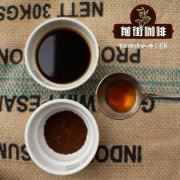Why is the espresso pressed powder so wet? why is the coffee pressed powder full of water?

Professional coffee knowledge exchange more coffee bean information please follow the coffee workshop (Wechat official account cafe_style)
It takes water to make espresso. The water is soaked through the coffee from top to bottom: before dripping onto the coffee powder, the water passes through the boiler, the head and the water distribution net. As soon as you start the pump, the water will fill the gap between the coffee powder and the water net, and then flow into and soak the coffee powder.
At this stage, water is everywhere: above, in and under the coffee powder. When you turn off the pump, a valve in the coffee machine opens to relieve pressure. Water does not compress under pressure, so there is not too much water leaking out at this time, just staying on the coffee powder and in the coffee powder. After there is no pressure, there is no force to push the water out of the powder bowl, and there is no force to push the water up to the head. The water just got stuck in the powder bowl.
If you remove the cooking handle quickly after the extraction, you will find a pool of water slowly seeping down into the coffee powder. After a few seconds, the coffee powder absorbed all the water.
The larger the gap between the coffee powder and the water distribution network, the more water will remain. And the more water you have left, the wetter and waterier your pressed powder will be.
Compared to other powder bowls, VST's powder bowl (which I personally highly recommend) is deeper. The advantage of this is that it makes the coffee powder less likely to reach the water distribution network after absorbing water and expanding. If the coffee powder is topped to the water distribution network, the extraction uniformity will become worse. There should be a gap between the coffee powder and the water distribution network to allow the water to seep evenly. Wet pressed powder is always much better than uneven extraction.
Pressed powder stagnant water, the residue wet sticky. The biggest culprit is the amount of powder!
No matter whether the coffee machine has a pressure relief valve or not, don't think that you have taken the standard 7g powder or 14g powder and filled it perfectly. After cooking the machine, I will certainly give you a beautiful pressed powder ~ No! The design of the water distribution network of each coffee is different from that of the powder bowl, and the distance depends on the amount of powder brewed into a "beautiful" coffee pressed powder.
Generally speaking, when you have finished filling the coffee powder and injecting water into the head to pressurize the coffee, the coffee pressed powder still expands a little after contacting the hot water. If the powder is grasped properly, the extraction will expand close to the water distribution network; when the extraction is stopped, the coffee machine will be able to absorb the excess water through the pressure relief valve, so that the pressed powder is not too wet and muddy.
Insufficient amount of coffee powder, the degree of expansion in the extraction process will not be enough, the gap between pressed powder and the water diversion network is too large, there will be stagnant water. Although there is a smoothing action in the cloth powder stage, it does not necessarily mean that your powder bowl is suitable for this. If you have seen the specifications of different coffee powder bowls, which are also used to make Double Espresso, there are more than 14g, 15g, 16g and 17g portions. Coffee beans (powder) with different roasting degrees have different densities, the grinding thickness of coffee powder will also affect the volume of the powder, and whether there is a tapping action in the powder process will also affect the true capacity of the powder bowl. So: smoothing the powder bowl does not necessarily mean that there is enough powder.
Of course, too little powder is not necessarily a bad thing, but too much powder is certainly not a good thing. If the amount of powder is too much, the filled pressed powder is easy to be too thick and too dense, and it is easy to crack and deform when touching the water diversion network on the head (especially a screw in the middle of some types of water distribution network), coupled with the expansion of water absorption, the extraction flow rate will become very unstable.
Important Notice :
前街咖啡 FrontStreet Coffee has moved to new addredd:
FrontStreet Coffee Address: 315,Donghua East Road,GuangZhou
Tel:020 38364473
- Prev

Beginners learn coffee pull flower coffee pull flower skills why do you want to pour the jar
Professional coffee knowledge exchange More coffee bean information Please pay attention to coffee workshop (Weixin Official Accounts cafe_style) Coffee flower production method 1 Milk: the most important technology, although not very advanced but need a long time of practice, require milk foam delicate and smooth, go to do not have big milk foam. 2 The angle of milk: It is best to make milk at a 45-degree angle with the steam nozzle, according to the fluctuation
- Next

Understanding the Coffee Channel effect Coffee extraction Channel effect will have a bad effect on hand grinding
Professional coffee knowledge exchange more coffee bean information Please follow the coffee workshop (Wechat official account cafe_style) when I first learned the channel effect, it was not long before I made coffee, because the coffee powder can not be well distributed in the powder bowl soon, my teacher often tells me that there are channels for your coffee. At that time, it was just according to the gourd.
Related
- Beginners will see the "Coffee pull flower" guide!
- What is the difference between ice blog purified milk and ordinary milk coffee?
- Why is the Philippines the largest producer of crops in Liberia?
- For coffee extraction, should the fine powder be retained?
- How does extracted espresso fill pressed powder? How much strength does it take to press the powder?
- How to make jasmine cold extract coffee? Is the jasmine + latte good?
- Will this little toy really make the coffee taste better? How does Lily Drip affect coffee extraction?
- Will the action of slapping the filter cup also affect coffee extraction?
- What's the difference between powder-to-water ratio and powder-to-liquid ratio?
- What is the Ethiopian local species? What does it have to do with Heirloom native species?

